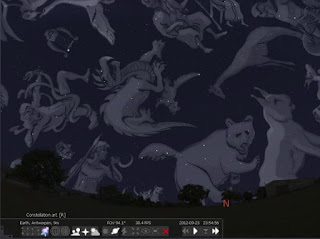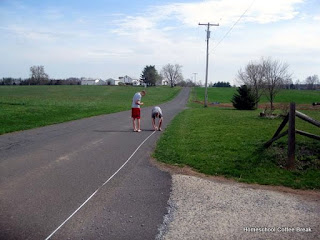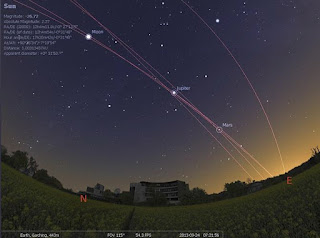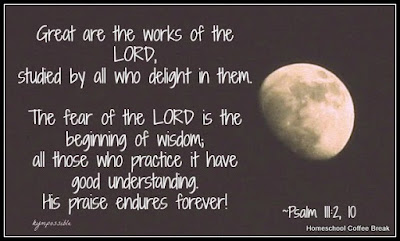This post contains affiliate links - using affiliate links from Homeschool Coffee Break helps fuel this blog and our homeschool - thank you!
After so many years of homeschooling, I've had plenty of opportunities to try curriculum and explore all kinds of resources, so during this Blogging Through the Alphabet tour, I'm highlighting some of the many homeschooling resources that have been stand-outs. Sometimes it will be a walk down memory lane as I share something we enjoyed many years ago, and sometimes it will be something we're using currently. Sometimes I'll focus on a specific curriculum, and sometimes on a subject area. And I imagine I'll have to be a bit creative with a couple letters of the alphabet! This week I'm looking back at a very interesting Science elective we did a few years ago - Classical Astronomy.

We used Signs and Seasons : Understanding the Elements of Classical Astronomy as our curriculum, along with the accompanying field guide, which contains chapter tests, templates and instructions for all the field activities, and places to keep records. All three of my students at that time completed the course, with the boys (in high school and in 8th grade at the time) both earning high school credit. Kennady was in 6th grade and did most of the course; she just didn't do all of the field activities with the boys. It's a great curriculum choice for families that are working together.


Although having a telescope is wonderful, you don't really need one to study classical astronomy. The idea is to be able to view the skies as the ancients did, and the course is designed so that you can complete all the activities without a telescope. Early in the course, students are encouraged to make a backyard compass. All the instructions are included, and we have a large backyard, so this was a fun project. In fact, about five years later, the cement tiles are still in our yard, and are a reference point for the cardinal directions.

What is Classical Astronomy? The textbook we chose described it as "the visual observation of the motions of the celestial bodies - the simple act of studying the cycles of the Sun, Moon and stars with our unaided eyes... a study of the celestial creation, not only for its usefulness, but also for its own natural beauty." So basically, viewing the sky and the sun, moon, and stars the way people have been doing since ancient times; and learning how to use the skies to mark the passage of time and to navigate. The Bible tells us that God created the Sun, Moon, and stars to give light and also to be signs for marking the days, seasons, and years.
And God said, Let there be lights in the firmament of the heaven, to divide the day from the night: and let them be for signs and for seasons, and for days and years. ~Genesis 1:14~

We used Signs and Seasons : Understanding the Elements of Classical Astronomy as our curriculum, along with the accompanying field guide, which contains chapter tests, templates and instructions for all the field activities, and places to keep records. All three of my students at that time completed the course, with the boys (in high school and in 8th grade at the time) both earning high school credit. Kennady was in 6th grade and did most of the course; she just didn't do all of the field activities with the boys. It's a great curriculum choice for families that are working together.
Although having a telescope is wonderful, you don't really need one to study classical astronomy. The idea is to be able to view the skies as the ancients did, and the course is designed so that you can complete all the activities without a telescope. Early in the course, students are encouraged to make a backyard compass. All the instructions are included, and we have a large backyard, so this was a fun project. In fact, about five years later, the cement tiles are still in our yard, and are a reference point for the cardinal directions.
 |
| Start with a stake pounded into the ground. Then mark where its shadow falls for several days. The shortest distance is the cardinal line running north to south. |

 |
| Our completed compass, but before final calibration. |
We also learned about and made all kinds of volvelles to help us understand the movements of the sun, moon, and constellations.

Activities with a globe helped us understand what was happening in the skies and how we see it on earth.
Other activities borrowed from various resources that were part of our study included using Oreo cookies to visualize the phases of the moon, and marking out the relative distances of the solar system on our road. Unexpected benefit of living on a country road!
For more information, you may want to see my related posts:
C is for . . . Classical Astronomy
An Astronomy Update

The heavens declare the glory of God; the skies proclaim the work of his hands. Day after day they pour forth speech; night after night they display knowledge. ~Psalm 19:1-2~


Activities with a globe helped us understand what was happening in the skies and how we see it on earth.
Other activities borrowed from various resources that were part of our study included using Oreo cookies to visualize the phases of the moon, and marking out the relative distances of the solar system on our road. Unexpected benefit of living on a country road!
 |
| After Jupiter, we pretty much gave up measuring. |
 |
| I hope the neighbors appreciated the detail of the asteroid belt as they drove by over the next day or two! |
A website we had a lot of fun with is Stellarium, which provides a free open source planetarium for your computer. Basically you can set it up to your home location and it will show you a planetarium style view of what you can see in the sky. This was very helpful in showing us where to look for specific planets and constellations and at what times.
 |
| constellation art turned on gives you an idea how the constellations got their names. |
C is for . . . Classical Astronomy
An Astronomy Update

The heavens declare the glory of God; the skies proclaim the work of his hands. Day after day they pour forth speech; night after night they display knowledge. ~Psalm 19:1-2~
Do you enjoy stargazing and learning about the sun, moon, and stars? Leave a comment and let me know!

Blogging Through the Alphabet again? Yes, I'm taking the challenge, along with several other Crew members, including our three co-hosts for this round - Amanda at Hopkins Homeschool, DaLynn at Biblical Womanhood, and Kirsten at DoodleMom's Homeschooling Life. The link is open from Thursday to Wednesday each week, so join in if you'd like!
This post is linked at Blogging Through the Alphabet for Week 3, Letter C.
This post is linked at Blogging Through the Alphabet for Week 3, Letter C.
This post is also linked at the Encouraging Hearts & Home Blog Hop hosted by Apron Strings & Other Things; and at Homeschool Blog & Tell at The Homeschool Post.

This post is also linked at the Homeschool Linky Party on the Homeschool Review Crew blog.
Don't miss a coffee break! Subscribe to Homeschool Coffee Break by Email!
©2006-2017 Homeschool Coffee Break. All rights reserved. All text, photographs, artwork, and other content may not be reproduced or transmitted in any form without the written consent of the author. http://kympossibleblog.blogspot.com/























































4 comments:
Wow! That course looks really great - and it looks like you made some wonderful memories at the same time. (you actually had me at the oreo moon phases - made me think how good they would go with a cup of coffee!
I love that you were able to complete all these activities without a telescope! We definitely tried the Oreo phases of the moon but I never thought of making a huge compass in the yard!
Great review. When we did astronomy, we also did the Oreo activity.
Such wonderful activities for hands-on learning. What fun. - Lori
Post a Comment
I love comments! It's like visiting over a virtual cup of coffee.